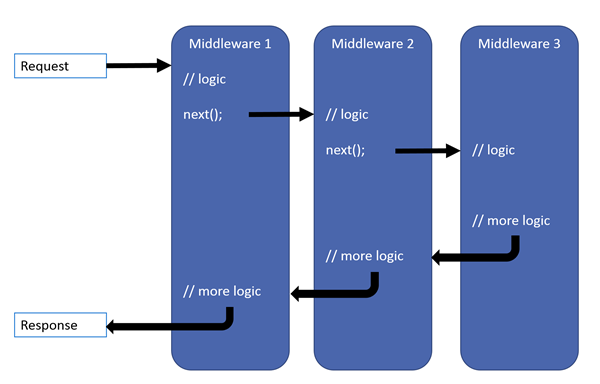asp.net core 系列之中间件基础篇(middleware)
中间件是一种插入到管道上进行处理请求和响应的软件;每个中间件组件具有下面的功能:
- 选择是否把请求传递到管道上的下一个组件
- 可以在下一个组件的之前和之后做处理工作
请求委托(request delegate)是用于建立(build)请求管道的,请求委托可以处理每个Http的请求;
请求委托被配置的方法有三种:Run、Map、Use 扩展方法;
用 IApplicationBuilder 创建中间件管道
请求管道由一系列请求委托组成,一个调用一个;如下图

每个委托都可以在下一个委托之前和之后执行。异常处理的委托在管道中被尽早调用,因为它可以捕获到后面管道中发生的错误。
单个的请求委托可以使用 run
使用一个匿名函数处理每个 Http 请求;并且使用的是 run ,它表示管道的结束,即最后一个中间件,不会再传递到下一个中间件
public class Startup { public void Configure(IApplicationBuilder app) { app.Run(async context => { await context.Response.WriteAsync("Hello, World!"); }); } }
链式的多个请求委托在一起,使用 use
next 参数 代表管道中的下一个委托,可以在下一个委托之前和之后进行处理;你也可以不调用 next 参数,直接短路管道(即不会传递到下一个委托/中间件)。
public class Startup { public void Configure(IApplicationBuilder app) { app.Use(async (context, next) => { // Do work that doesn't write to the Response. await next.Invoke(); // Do logging or other work that doesn't write to the Response. }); app.Run(async context => { await context.Response.WriteAsync("Hello from 2nd delegate."); }); } }
顺序
这里的顺序是指中间件被加到 Startup.Configure 方法的顺序决定了中间件顺序处理请求和逆序处理响应。所以,添加顺序是很重要的
一般的应用中的 Startup.Configure 方法添加中间组件的顺序:
- Exception/error handling
- HTTP Strict Transport Security Protocol
- HTTPS redirection
- Static file server
- Cookie policy enforcement
- Authentication
- Session
- MVC
public void Configure(IApplicationBuilder app) { if (env.IsDevelopment()) { // When the app runs in the Development environment: // Use the Developer Exception Page to report app runtime errors. // Use the Database Error Page to report database runtime errors.
// 添加异常中间件之后,后面中间件发生的异常都会被捕获
app.UseDeveloperExceptionPage(); app.UseDatabaseErrorPage(); } else { // When the app doesn't run in the Development environment: // Enable the Exception Handler Middleware to catch exceptions // thrown in the following middlewares. // Use the HTTP Strict Transport Security Protocol (HSTS) // Middleware. app.UseExceptionHandler("/Error"); app.UseHsts(); } // Use HTTPS Redirection Middleware to redirect HTTP requests to HTTPS.使用https重定向中间件来重定向http请求到https请求 app.UseHttpsRedirection(); // Return static files and end the pipeline. app.UseStaticFiles(); // Use Cookie Policy Middleware to conform to EU General Data // Protection Regulation (GDPR) regulations. app.UseCookiePolicy(); // Authenticate before the user accesses secure resources. app.UseAuthentication(); // If the app uses session state, call Session Middleware after Cookie // Policy Middleware and before MVC Middleware. app.UseSession(); // Add MVC to the request pipeline. app.UseMvc(); }
Use , Run 和 Map 的用法
使用 Use , Run 和 Map 配置 HTTP 管道。
Use 方法如果不调用next 就会造成短路;
一些中间件组件可能会暴露 Run [ Middleware ] 方法 在管道的结束处运行;
Map 扩展 主要用作一种分支管道的惯例:
Map* 根据这给出的请求路径是否匹配来进入管道。
public class Startup { private static void HandleMapTest1(IApplicationBuilder app) { app.Run(async context => { await context.Response.WriteAsync("Map Test 1"); }); } private static void HandleMapTest2(IApplicationBuilder app) { app.Run(async context => { await context.Response.WriteAsync("Map Test 2"); }); } public void Configure(IApplicationBuilder app) { app.Map("/map1", HandleMapTest1); app.Map("/map2", HandleMapTest2); app.Run(async context => { await context.Response.WriteAsync("Hello from non-Map delegate. <p>"); }); } }
如果路径匹配 /map1 ,则执行 HandleMapTest1;
如果路径匹配 /map2 , 则执行 HandleMapTest2 ;
如下示例:

MapWhen 的用法
当满足某个条件时,执行
public class Startup { private static void HandleBranch(IApplicationBuilder app) { app.Run(async context => { var branchVer = context.Request.Query["branch"]; await context.Response.WriteAsync($"Branch used = {branchVer}"); }); } public void Configure(IApplicationBuilder app) { app.MapWhen(context => context.Request.Query.ContainsKey("branch"), HandleBranch); app.Run(async context => { await context.Response.WriteAsync("Hello from non-Map delegate. <p>"); }); } }
示例如下:

另外,map支持嵌套
app.Map("/level1", level1App => { level1App.Map("/level2a", level2AApp => { // "/level1/level2a" processing }); level1App.Map("/level2b", level2BApp => { // "/level1/level2b" processing }); });
而且,map支持每次匹配多个段
public class Startup { private static void HandleMultiSeg(IApplicationBuilder app) { app.Run(async context => { await context.Response.WriteAsync("Map multiple segments."); }); } public void Configure(IApplicationBuilder app) { app.Map("/map1/seg1", HandleMultiSeg); //此句示例 app.Run(async context => { await context.Response.WriteAsync("Hello from non-Map delegate."); }); } }
另外还有很多内置的中间件可供使用,可根据需要进行使用
参考网址:
https://docs.microsoft.com/en-us/aspnet/core/fundamentals/middleware/?view=aspnetcore-2.2






【推荐】国内首个AI IDE,深度理解中文开发场景,立即下载体验Trae
【推荐】编程新体验,更懂你的AI,立即体验豆包MarsCode编程助手
【推荐】抖音旗下AI助手豆包,你的智能百科全书,全免费不限次数
【推荐】轻量又高性能的 SSH 工具 IShell:AI 加持,快人一步
· AI与.NET技术实操系列:基于图像分类模型对图像进行分类
· go语言实现终端里的倒计时
· 如何编写易于单元测试的代码
· 10年+ .NET Coder 心语,封装的思维:从隐藏、稳定开始理解其本质意义
· .NET Core 中如何实现缓存的预热?
· 分享一个免费、快速、无限量使用的满血 DeepSeek R1 模型,支持深度思考和联网搜索!
· 基于 Docker 搭建 FRP 内网穿透开源项目(很简单哒)
· 25岁的心里话
· ollama系列01:轻松3步本地部署deepseek,普通电脑可用
· 按钮权限的设计及实现